Avoid losing your account via fake "Quote For The Attached Products" emails
Phishing/ScamAlso Known As: "Quote For The Attached Products" phishing email
Get free scan and check if your device is infected.
Remove it nowTo use full-featured product, you have to purchase a license for Combo Cleaner. Seven days free trial available. Combo Cleaner is owned and operated by RCS LT, the parent company of PCRisk.com.
What kind of email is "Quote For The Attached Products"?
Upon examination, we determined that the "Quote For The Attached Products" email is spam. It is presented as a potential purchase inquiry that directs users into accessing a nonexistent attachment. The goal of the spam mail is to redirect recipients to a phishing website that targets log-in credentials.
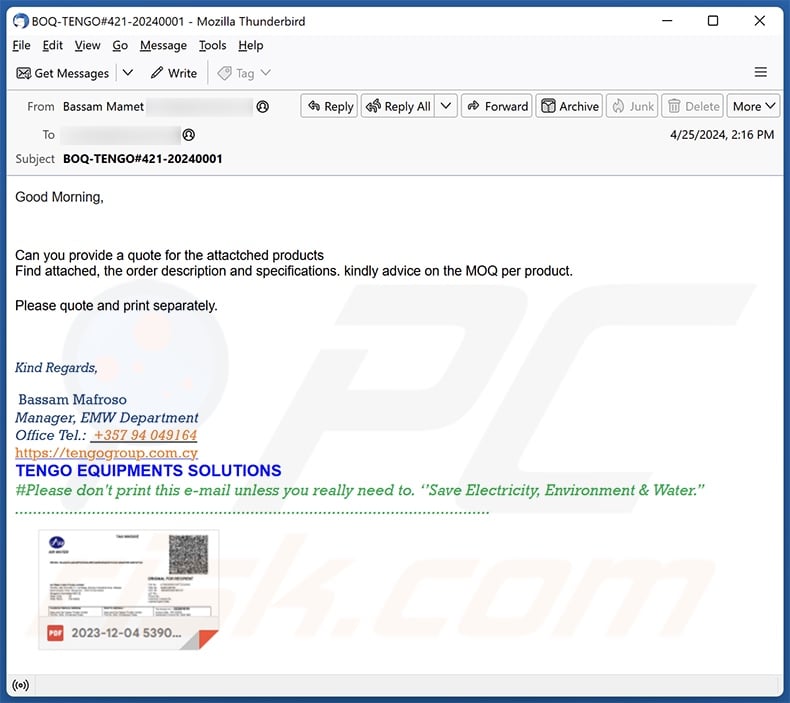
"Quote For The Attached Products" email scam overview
The spam email with the subject "BOQ-TENGO#421-20240001" (may vary) requests the recipient to review the attached product quote. The attachment contains the order description and specifications. The recipient is also asked to provide the Minimum Order Quantity (MOQ).
It must be stressed that this email is a scam, and it is not associated with any genuine companies or other entities.
The letter does not have any attachments – this is merely a lure to trick recipients into visiting a phishing website disguised as an email portal. The fake page claims – "You're accessing a confidential document, Please Confirm Email password to continue." – naturally, this site targets log-in credentials.
The risk of trusting this letter/website exceeds the theft of an email. Mail accounts can contain vulnerable data, and they are used to register other content. Hence, through a hijacked email – cyber criminals might be able to gain control over linked accounts or platforms.
This unauthorized access can be variously misused. For example, scammers can steal the identities of account owners (e.g., emails, social networking/media, messengers, chats, etc.) and ask for loans or donations from contacts/friends/followers, promote scams, and spread malware by sharing malicious files/links.
Sensitive content discovered on compromised data storage or similar platforms could be used for blackmail or other nefarious purposes. Stolen finance-related accounts (e.g., e-commerce, money transferring, online banking, digital wallets, etc.) can be used to facilitate fraudulent transactions or online purchases.
In summary, victims of spam mail like "Quote For The Attached Products" can experience serious privacy issues, financial losses, and even identity theft.
If you have already provided your account credentials – change the passwords of all potentially exposed accounts and contact their official support without delay.
| Name | "Quote For The Attached Products" phishing email |
| Threat Type | Phishing, Scam, Social Engineering, Fraud |
| Fake Claim | Recipient is requested to review and provide information regarding the attached product quote. |
| Symptoms | Unauthorized online purchases, changed online account passwords, identity theft, illegal access of the computer. |
| Distribution methods | Deceptive emails, rogue online pop-up ads, search engine poisoning techniques, misspelled domains. |
| Damage | Loss of sensitive private information, monetary loss, identity theft. |
| Malware Removal (Windows) |
To eliminate possible malware infections, scan your computer with legitimate antivirus software. Our security researchers recommend using Combo Cleaner. Download Combo CleanerTo use full-featured product, you have to purchase a license for Combo Cleaner. 7 days free trial available. Combo Cleaner is owned and operated by RCS LT, the parent company of PCRisk.com. |
Phishing spam campaign examples
"Salary Increase", "Claim Sum Release", and "Roundcube Password Set To Expire" are just a couple of our latest articles on phishing spam campaigns. Most commonly targeted information includes log-in credentials, personally identifiable details, and finance-related data.
However, spam mail is used to promote various other scams, and it is prevalent in malware proliferation. While these emails are infamous for being full of spelling/grammatical mistakes and other inconsistencies, they can also be competently crafted and even believably disguised as messages from legitimate entities (e.g., companies, institutions, service providers, authorities, etc.).
How do spam campaigns infect computers?
Malware is distributed through spam campaigns in malicious files that are attached to or linked inside the emails/messages. These files can be archives (RAR, ZIP, etc.), executables (.exe, .run, etc.), documents (Microsoft Office, Microsoft OneNote, PDF, etc.), JavaScript, and so forth.
When a virulent file is opened – the malware download/installation chain is triggered. However, some formats need additional user interaction to initiate these processes. For example, Microsoft Office files require users to enable macro commands (i.e., editing/content), while OneNote documents need them to click embedded links or files.
How to avoid installation of malware?
We strongly advise exercising caution with incoming emails, DMs/PMs, SMSes, and other messages. Do not open attachments or links found in suspicious/irrelevant mail, as they can be harmful/infectious.
It must be mentioned that malware is not spread only through spam mail. Hence, our other recommendations include vigilance while browsing, as fake and malicious online content typically appears genuine and harmless.
Additionally, download only from official and trustworthy channels. Activate and update software using legitimate functions/tools, as illegal activation ("cracking") tools and third-party updates can contain malware.
We must stress the importance of having a dependable anti-virus installed and kept updated. Security programs must be used to run regular system scans and to remove detected threats. If you've already opened malicious attachments, we recommend running a scan with Combo Cleaner Antivirus for Windows to automatically eliminate infiltrated malware.
Text presented in the "Quote For The Attached Products" spam email letter:
Subject: BOQ-TENGO#421-20240001
Good Morning,
Can you provide a quote for the attactched products
Find attached, the order description and specifications. kindly advice on the MOQ per product.
Please quote and print separately.
Kind Regards,
Bassam Mafroso
Manager, EMW Department
Office Tel.: +357 94 049164
hxxps://tengogroup.com.cy
TENGO EQUIPMENTS SOLUTIONS
#Please don't print this e-mail unless you really need to. ‘’Save Electricity, Environment & Water.’’
Screenshot of the phishing website promoted by the "Quote For The Attached Products" spam campaign:
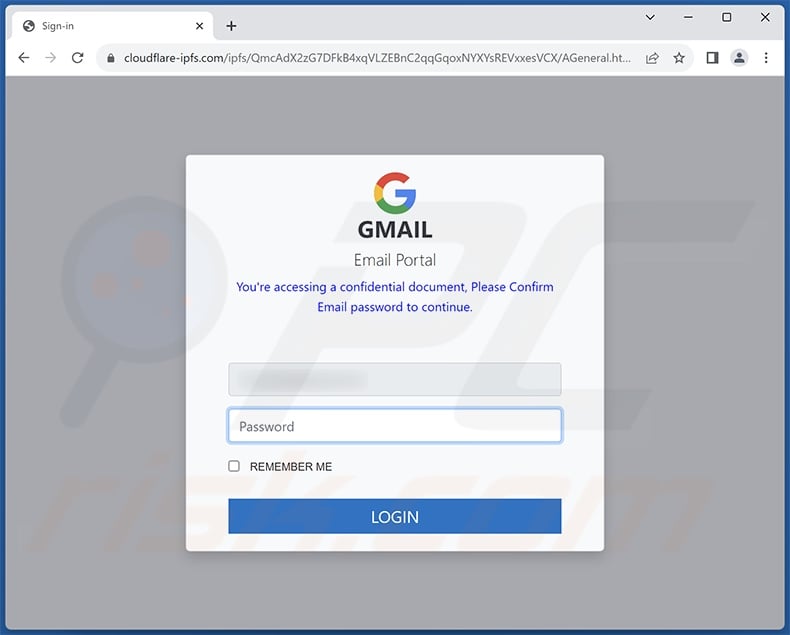
Other examples of emails from "Quote For The Attached Products" spam campaign:
Sample 1:
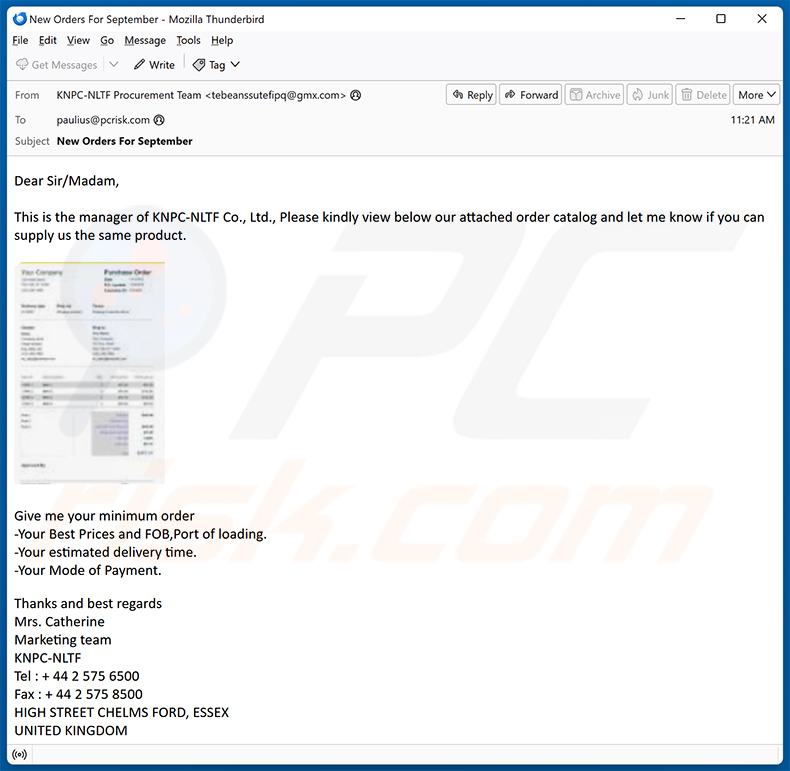
Text presented within:
Subject: New Orders For September
Dear Sir/Madam,
This is the manager of KNPC-NLTF Co., Ltd., Please kindly view below our attached order catalog and let me know if you can supply us the same product.
Give me your minimum order
-Your Best Prices and FOB,Port of loading.
-Your estimated delivery time.
-Your Mode of Payment.Thanks and best regards
Mrs. Catherine
Marketing team
KNPC-NLTF
Tel : + 44 2 575 6500
Fax : + 44 2 575 8500
HIGH STREET CHELMS FORD, ESSEX
UNITED KINGDOM
Sample 2:
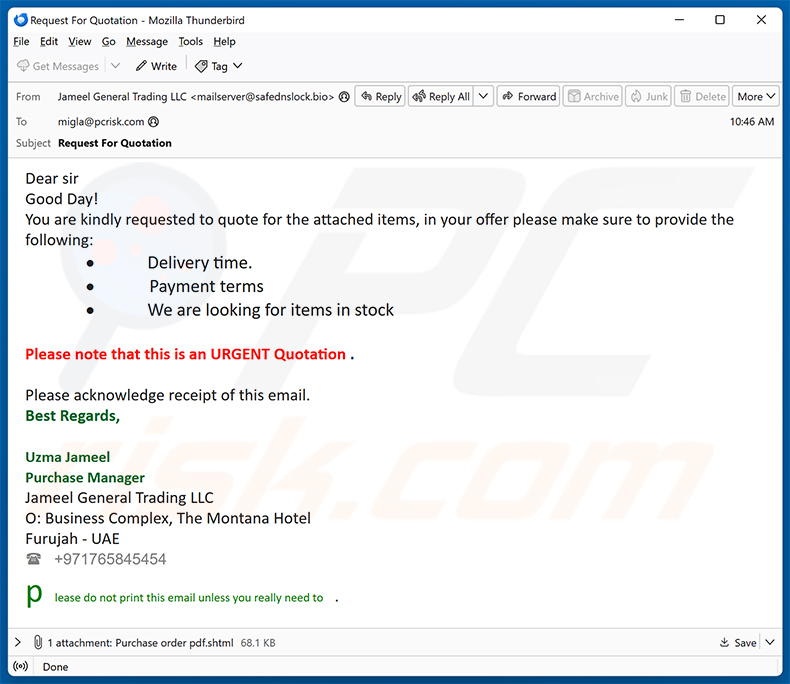
Text presented within:
Subject: Request For Quotation
Dear sir
Good Day!
You are kindly requested to quote for the attached items, in your offer please make sure to provide the following:
Delivery time.
Payment terms
We are looking for items in stock
Please note that this is an URGENT Quotation .
Please acknowledge receipt of this email.
Best Regards,
Uzma Jameel
Purchase Manager
Jameel General Trading LLC
O: Business Complex, The Montana Hotel
Furujah - UAE
+971765845454
please do not print this email unless you really need to.
Screenshot of the attached HTML phishing document:
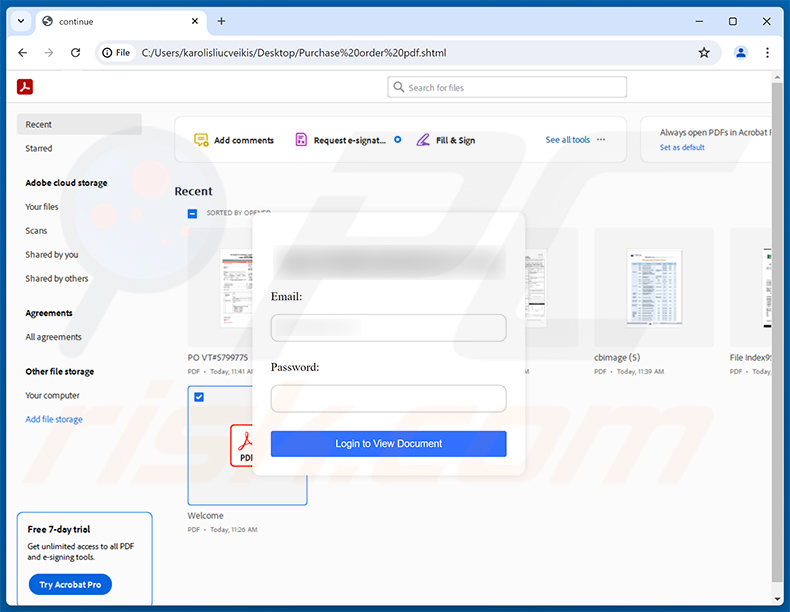
Sample 3:
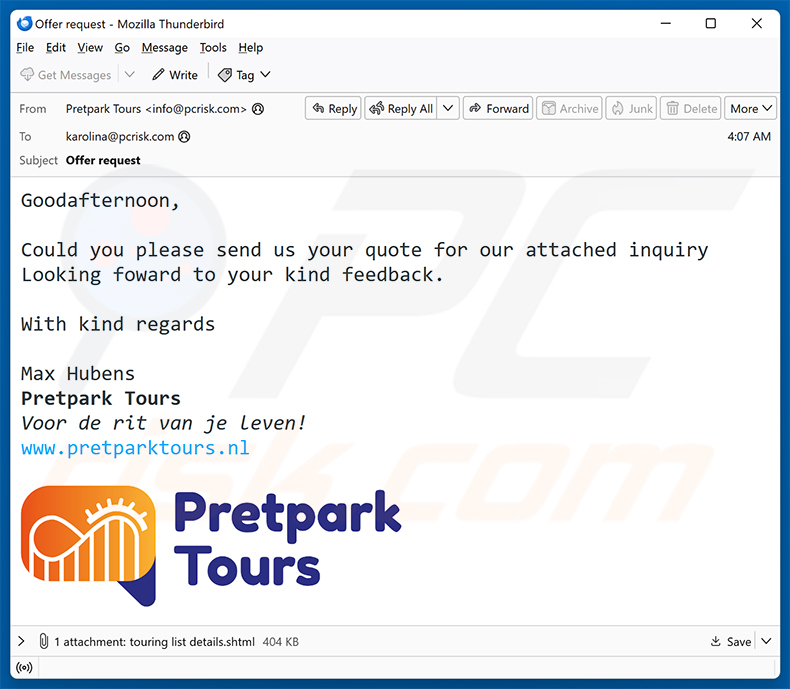
Text presented within:
Subject: Offer request
Goodafternoon,
Could you please send us your quote for our attached inquiry
Looking foward to your kind feedback.With kind regards
Max Hubens
Pretpark Tours
Voor de rit van je leven!
www.pretparktours.nl
Screenshot of the attached phishing HTML file:
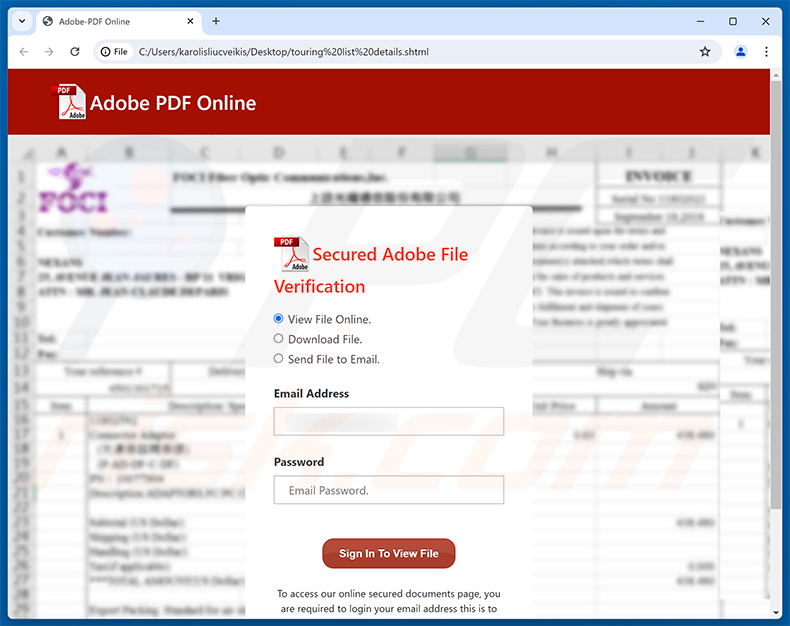
Instant automatic malware removal:
Manual threat removal might be a lengthy and complicated process that requires advanced IT skills. Combo Cleaner is a professional automatic malware removal tool that is recommended to get rid of malware. Download it by clicking the button below:
DOWNLOAD Combo CleanerBy downloading any software listed on this website you agree to our Privacy Policy and Terms of Use. To use full-featured product, you have to purchase a license for Combo Cleaner. 7 days free trial available. Combo Cleaner is owned and operated by RCS LT, the parent company of PCRisk.com.
Quick menu:
- What is "Quote For The Attached Products" phishing email?
- Types of malicious emails.
- How to spot a malicious email?
- What to do if you fell for an email scam?
Types of malicious emails:
![]() Phishing Emails
Phishing Emails
Most commonly, cybercriminals use deceptive emails to trick Internet users into giving away their sensitive private information, for example, login information for various online services, email accounts, or online banking information.
Such attacks are called phishing. In a phishing attack, cybercriminals usually send an email message with some popular service logo (for example, Microsoft, DHL, Amazon, Netflix), create urgency (wrong shipping address, expired password, etc.), and place a link which they hope their potential victims will click on.
After clicking the link presented in such email message, victims are redirected to a fake website that looks identical or extremely similar to the original one. Victims are then asked to enter their password, credit card details, or some other information that gets stolen by cybercriminals.
![]() Emails with Malicious Attachments
Emails with Malicious Attachments
Another popular attack vector is email spam with malicious attachments that infect users' computers with malware. Malicious attachments usually carry trojans that are capable of stealing passwords, banking information, and other sensitive information.
In such attacks, cybercriminals' main goal is to trick their potential victims into opening an infected email attachment. To achieve this goal, email messages usually talk about recently received invoices, faxes, or voice messages.
If a potential victim falls for the lure and opens the attachment, their computers get infected, and cybercriminals can collect a lot of sensitive information.
While it's a more complicated method to steal personal information (spam filters and antivirus programs usually detect such attempts), if successful, cybercriminals can get a much wider array of data and can collect information for a long period of time.
![]() Sextortion Emails
Sextortion Emails
This is a type of phishing. In this case, users receive an email claiming that a cybercriminal could access the webcam of the potential victim and has a video recording of one's masturbation.
To get rid of the video, victims are asked to pay a ransom (usually using Bitcoin or another cryptocurrency). Nevertheless, all of these claims are false - users who receive such emails should ignore and delete them.
How to spot a malicious email?
While cyber criminals try to make their lure emails look trustworthy, here are some things that you should look for when trying to spot a phishing email:
- Check the sender's ("from") email address: Hover your mouse over the "from" address and check if it's legitimate. For example, if you received an email from Microsoft, be sure to check if the email address is @microsoft.com and not something suspicious like @m1crosoft.com, @microsfot.com, @account-security-noreply.com, etc.
- Check for generic greetings: If the greeting in the email is "Dear user", "Dear @youremail.com", "Dear valued customer", this should raise suspiciousness. Most commonly, companies call you by your name. Lack of this information could signal a phishing attempt.
- Check the links in the email: Hover your mouse over the link presented in the email, if the link that appears seems suspicious, don't click it. For example, if you received an email from Microsoft and the link in the email shows that it will go to firebasestorage.googleapis.com/v0... you shouldn't trust it. It's best not to click any links in the emails but to visit the company website that sent you the email in the first place.
- Don't blindly trust email attachments: Most commonly, legitimate companies will ask you to log in to their website and to view any documents there; if you received an email with an attachment, it's a good idea to scan it with an antivirus application. Infected email attachments are a common attack vector used by cybercriminals.
To minimise the risk of opening phishing and malicious emails we recommend using Combo Cleaner Antivirus for Windows.
Example of a spam email:

What to do if you fell for an email scam?
- If you clicked on a link in a phishing email and entered your password - be sure to change your password as soon as possible. Usually, cybercriminals collect stolen credentials and then sell them to other groups that use them for malicious purposes. If you change your password in a timely manner, there's a chance that criminals won't have enough time to do any damage.
- If you entered your credit card information - contact your bank as soon as possible and explain the situation. There's a good chance that you will need to cancel your compromised credit card and get a new one.
- If you see any signs of identity theft - you should immediately contact the Federal Trade Commission. This institution will collect information about your situation and create a personal recovery plan.
- If you opened a malicious attachment - your computer is probably infected, you should scan it with a reputable antivirus application. For this purpose, we recommend using Combo Cleaner Antivirus for Windows.
- Help other Internet users - report phishing emails to Anti-Phishing Working Group, FBI’s Internet Crime Complaint Center, National Fraud Information Center and U.S. Department of Justice.
Frequently Asked Questions (FAQ)
Why did I receive this email?
Regardless of any relevant details that they may include, spam emails are not personal. These messages are sent out in large-scale campaigns – therefore, thousands of users receive identical (or incredibly similar) emails.
I have provided my personal information when tricked by this spam email, what should I do?
If you have provided your log-in credentials – change the passwords of all possibly compromised accounts and inform their official support. And if you've disclosed other private data (e.g., ID card details, credit card numbers, etc.) – contact the appropriate authorities.
I have read a spam email but didn't open the attachment, is my computer infected?
No, reading an email will not trigger any malware download/installation processes. Devices are infected when malicious attachments or links are opened/clicked.
I have downloaded and opened a file attached to a spam email, is my computer infected?
If the opened file was an executable (.exe, .run, etc.) – most likely, yes – the device was infected since these files cause infections almost without fail. However, you might have avoided this if it was a document (.doc, .xls, .pdf, .one, etc.). These formats can require extra actions to start downloading/installing malware (e.g., enabling macro commands, clicking embedded files/links, etc.).
Will Combo Cleaner remove malware infections present in email attachments?
Yes, Combo Cleaner is capable of detecting and eliminating most of the known malware infections. It must be emphasized that performing a full system scan is crucial since high-end malicious programs typically hide deep within systems.
Share:

Tomas Meskauskas
Expert security researcher, professional malware analyst
I am passionate about computer security and technology. I have an experience of over 10 years working in various companies related to computer technical issue solving and Internet security. I have been working as an author and editor for pcrisk.com since 2010. Follow me on Twitter and LinkedIn to stay informed about the latest online security threats.
PCrisk security portal is brought by a company RCS LT.
Joined forces of security researchers help educate computer users about the latest online security threats. More information about the company RCS LT.
Our malware removal guides are free. However, if you want to support us you can send us a donation.
DonatePCrisk security portal is brought by a company RCS LT.
Joined forces of security researchers help educate computer users about the latest online security threats. More information about the company RCS LT.
Our malware removal guides are free. However, if you want to support us you can send us a donation.
Donate
▼ Show Discussion